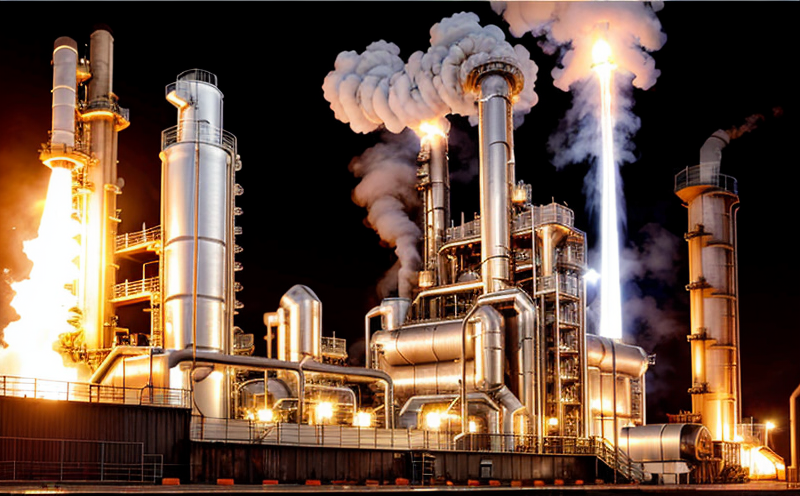ASTM E1019 Analysis of N, C, S, O in Steel and Alloys
The ASTM E1019 standard method is a critical analytical technique used to determine the nitrogen (N), carbon (C), sulfur (S), and oxygen (O) content in steel and alloys. This service plays a crucial role in ensuring that materials meet specified quality standards, particularly in industries such as metallurgy, manufacturing, automotive, and aerospace.
The ASTM E1019 method is part of the broader suite of analytical tools used to control and refine metals during processing. Nitrogen, carbon, sulfur, and oxygen are trace elements found in various steel grades that can significantly impact its properties. For instance, too much nitrogen can lead to embrittlement, while excessive carbon or sulfur can cause hot shortness or poor weldability.
The analytical process typically involves sample preparation, which may include melting the sample with a flux and then using a gas phase analysis method such as Inductively Coupled Plasma-Optical Emission Spectroscopy (ICP-OES) for quantification. The standard specifies detailed procedures to ensure accurate results, including the use of reference materials and calibration standards.
Understanding these elemental components is vital because they influence key characteristics like hardness, strength, ductility, and weldability. By accurately measuring these elements, laboratories can provide precise data that helps manufacturers make informed decisions about material selection and process adjustments.
This service not only aids in compliance with international standards but also supports ongoing quality assurance programs by providing reliable, repeatable results. It is essential for industries where even small variations in elemental composition can lead to significant performance differences or safety concerns.
- Elemental analysis ensures that steel and alloy compositions meet the required specifications as per ASTM E1019 and other relevant standards.
- The method supports process control, helping manufacturers maintain consistent product quality across batches.
- It enables the identification of potential issues early in the production cycle, reducing rework costs and improving overall efficiency.
- Data from this analysis can be used to optimize steel-making processes, leading to improved product performance and reduced environmental impact.
The accuracy and precision of ASTM E1019 analysis are crucial for industries relying on high-quality metals. By adhering strictly to the standard's guidelines, laboratories ensure that results are consistent and comparable across different batches and locations.
Why It Matters
The importance of ASTM E1019 lies in its ability to provide precise information about key trace elements in steel and alloys. These elements can significantly influence the material's properties, making accurate measurement critical for quality assurance and process control.
For example, nitrogen (N) plays a role in grain size refinement and solidification processes but can also cause embrittlement if present in excess. Carbon (C), while essential for hardening steel through heat treatment, is often kept within specific limits to prevent excessive hardness or brittleness. Sulfur (S) is undesirable as it can lead to hot shortness, a condition where the material fails during forging or welding processes. Oxygen (O) contributes to the formation of oxides on the surface and inclusions within the metal matrix.
By accurately measuring these elements, ASTM E1019 helps ensure that materials meet the stringent requirements set by industry standards. This is particularly important for applications where material integrity is paramount, such as in aerospace components or structural steel used in construction projects.
The standard's adherence to international norms ensures that results are universally recognized and accepted, facilitating trade and collaboration between different entities within the metallurgy sector. Compliance with ASTM E1019 not only enhances product reliability but also supports regulatory compliance and safety standards across various industries.
Quality and Reliability Assurance
The quality and reliability of results from ASTM E1019 analysis are paramount for ensuring consistent material performance. Laboratories must adhere strictly to the standard's procedures, which include precise sample preparation and calibration using reference materials.
- Reference Materials: The use of certified reference materials helps ensure that the analytical method produces reliable results. These materials serve as a benchmark against which test results can be compared.
- Calibration Standards: Regular calibration with known standards ensures that instruments are accurate and consistent. This is crucial for maintaining precision across multiple analyses.
- Repeatability: The standard specifies conditions under which results should remain consistent, allowing for reproducible outcomes in different laboratories.
- Data Validation: Cross-referencing results with other analytical methods can further validate the accuracy of ASTM E1019 data. This is particularly useful when dealing with complex or challenging samples where single method validation might not be sufficient.
By implementing these quality assurance measures, laboratories can provide clients with confidence in the reliability and accuracy of their analysis. This trust is essential for maintaining high standards within the metallurgy sector and ensuring that materials meet critical performance criteria.
Competitive Advantage and Market Impact
The ability to accurately measure trace elements like nitrogen, carbon, sulfur, and oxygen using ASTM E1019 provides a significant competitive edge in the metallurgy industry. These measurements are essential for optimizing steel-making processes, ensuring product quality, and maintaining compliance with international standards.
For manufacturers, precise elemental analysis through ASTM E1019 can lead to cost savings by identifying inefficiencies early in the production process. This allows for timely adjustments that improve efficiency without compromising on quality. Additionally, meeting or exceeding industry specifications can enhance a company's reputation and market standing, attracting more customers and partnerships.
In terms of market impact, accurate analysis supports the development of new materials with enhanced properties. By understanding how trace elements influence material behavior, researchers can innovate and introduce products that meet emerging demands in various sectors such as automotive, aerospace, and construction.
The global demand for high-quality steel and alloys continues to grow, driven by increasing infrastructure projects and technological advancements. ASTM E1019 analysis helps ensure that the materials used in these projects are reliable and performant, contributing positively to their success. This service not only supports individual companies but also contributes to broader industry growth and development.





